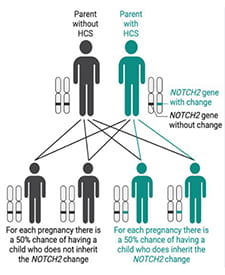What is Hajdu Cheney Syndrome?
Hajdu-Cheney Syndrome (HCS) is a rare connective tissue disorder caused by changes in the NOTCH2 gene. This gene is involved in the development of many tissues in the body. It also has a role in bone formation and breakdown.
Fewer than 100 people are reported as having Hajdu Cheney syndrome. The exact number of affected individuals in the general population is unknown. Men and women get Hajdu Cheney syndrome equally.
What Causes Hajdu Cheney Syndrome?
Changes in the DNA near the end of the NOTCH2 gene cause Hajdu Cheney syndrome. These changes cause the protein made from the NOTCH2 gene to be shorter and active longer than usual. We don’t fully understand how this leads to all the symptoms of Hajdu Cheney syndrome.
Changes in NOTCH2 can be inherited from an affected parent. In other cases it is a new, random change found only in the individual with Hajdu Cheney syndrome. There is nothing a person did to cause themselves or their child to have a NOTCH2 change.
How is Hajdu Cheney Syndrome Inherited?
Hajdu Cheney syndrome is inherited in an autosomal dominant manner. This means:
- You only need one copy of the NOTCH2 gene with a change to show signs and symptoms of HCS.
- If a parent has HCS, each child they have has a 50% chance to inherit the copy of NOTCH2 that has a change and be diagnosed with HCS.
- Both males and females can inherit and pass down NOTCH2 changes that cause HCS.
People who have HCS and want to have children without the condition can use a method called preimplantation genetic testing (PGT). This involves testing embryos for changes in NOTCH2 before they are transferred into the uterus (womb) using in vitro fertilization (IVF). Genetic counselors are a good source of information about preimplantation genetic testing.
What are the Symptoms of Hajdu Cheney Syndrome?
The symptoms and severity of Hajdu Cheney syndrome vary from person to person. Most people with Hajdu Cheney have low bone density (osteoporosis) and breakdown of bone in the fingers and toes (acro-osteolysis).
People with Hajdu Cheney syndrome can also have other features listed below. Each person may not experience all features listed:
- Extremely flexible joints
- Bones that fracture or break more easily
- Curved long bones in the arms and legs (serpentine fibulae)
- A build-up of fluid on the brain (hydrocephalus)
- Bones of the spine pushing up into the skull and brain (basilar invagination)
- Brain tissue extending into the spinal canal due to defects at the base of the skull (Chiari malformation)
- Heart defects present at birth, such as a hole in the heart
- A curved spine (scoliosis, kyphosis)
- Fractures in the bones that make up the spine (vertebrae)
- Short stature
- Multiple sacs of fluid (cysts) in the kidneys
- Early loss of adult teeth
- An opening in the roof of the mouth (cleft palate)
- Underbite or overbite
- Differences in skull shape
- Skull bones that do not fuse or close after birth (open skull sutures)
- Coarse facial features
How is Hajdu Cheney Syndrome Treated?
Currently there are no agreed-upon treatments or guidelines for treating Hajdu Cheney syndrome. Instead, doctors focus on managing each patient’s symptoms. Patients may need surgeries to treat complications of Hajdu Cheney. The most common surgeries involve the heart, spine, skull, and / or kidneys.
Medications like bisphosphonates may help lower the chance of bone breaks and fractures. These medications may be used to increase bone density in groups such as women who have gone through menopause. These medications have increased bone density for some people with Hajdu Cheney syndrome. There is not clear evidence that a particular bone treatment is effective in people with Hajdu Cheney.




